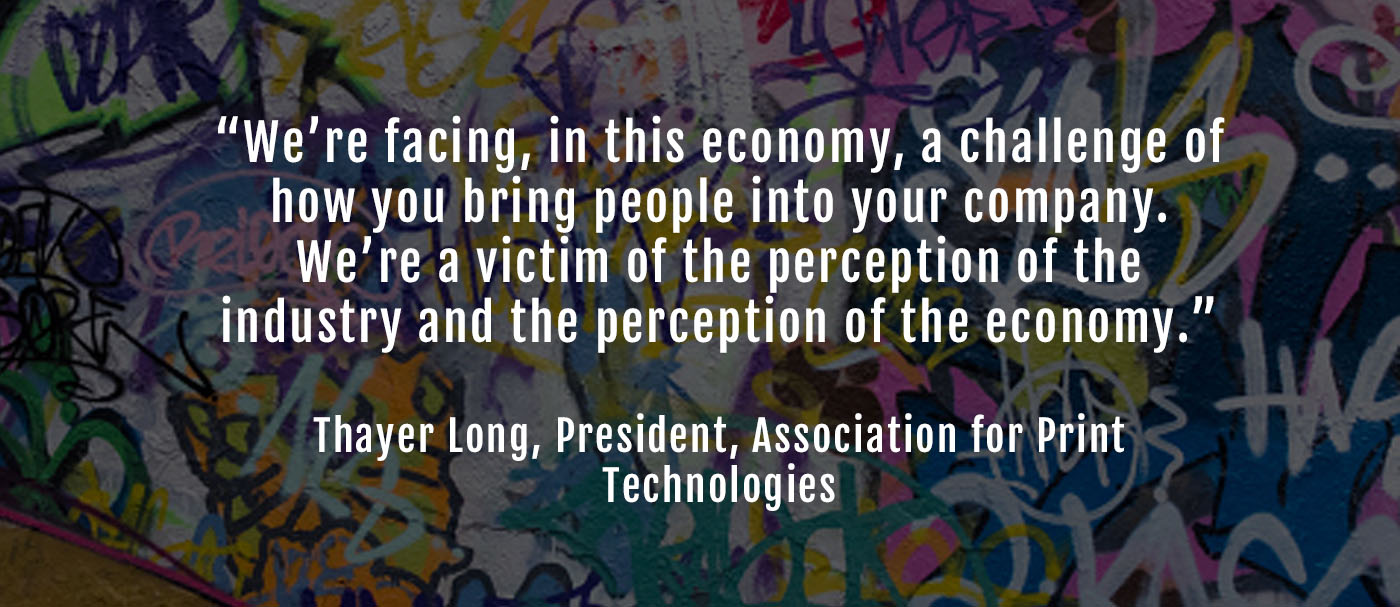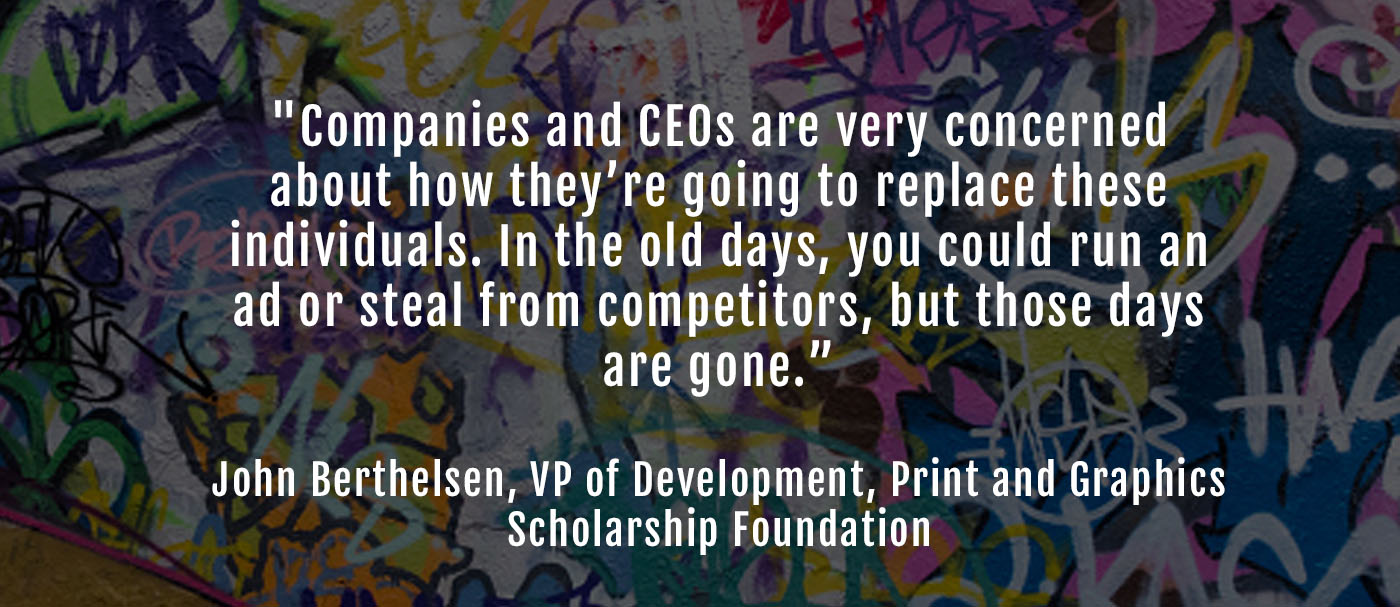“People are working very locally. They are working with local high schools, educators and teachers to try and promote the printing industry.”
— John Braceland, CEO, Graphic Arts Alliance
Millennials have purportedly “killed” a slew of industries. Applebee’s, diamonds and napkins are among the fallen, according to a recent Business Insider article. These are just a few of the types of markets taking a hit from the preferences of millennials.
And while print has been pronounced “dead” for a decade or so, millennials will be the ones to resuscitate it. In fact, print is one of the few industries that has not taken a huge hit from Generation Y’s buying preferences, though looking at the decline in print media might suggest otherwise.
“In the last four to five years, print has shown it’s not going away,” says John Braceland, CEO of Graphic Arts Alliance. “It may be diminishing or changing, but it’s not going away.”
It’s a message that must be championed as the print and graphic communications industries face impending workforce woes. These companies’ current employees are nearing retirement age, and if leaders don’t do anything to start bringing in the millennials, their print companies will die. Millennials—aged between 23 and 38 in 2019—make up at least one-third of the overall workforce in the United States. That number is slated to increase to 75 percent by the year 2030, according to the U.S. Bureau of Labor Statistics.

“In the next 10 to 15 years,” Braceland says, “retirement will hit its peak, and that will make the issue more critical.”
Braceland’s sentiments are echoed by John Berthelsen, VP of development for the Print and Graphics Scholarship Foundation (PGSF). He says that for anyone who considers themselves more of a manufacturing job, a trained skill, or jobs that require at least a two-year degree, there’s a huge workforce gap.
“We’ve been faced with this for at least a decade,” Berthelsen says. “Unfortunately, the need is now more acute because the baby boom generation is beginning to exit the workforce. Companies and CEOs are very concerned about how they’re going to replace these individuals. In the old days, you could run an ad or steal from competitors, but those days are gone.”
So, how does a printing company avoid becoming a fatality like many other industries in the age of the millennial? Get the millennials on board.
Attracting young talent
Print’s reputation, unfortunately, precedes it. Industry thought leaders agree that the biggest problem facing the industry is its perception. The media has told the public for the past decade that print is dying, so why would a bright-eyed millennial, new to the workforce, want to start a career in a dying industry? You can’t blame this younger generation for its apprehensiveness.
You can, however, blame print companies for not changing the public’s perception of the industry. Even though printers know that the industry is not phasing out—rather, it’s changing—others outside of the industry do not.
While organizations such as the PGSF are working to attract young people to consider graphic communications as a career choice and are educating the students and their parents about the available opportunities, the reality is that companies still need to pull their weight. PGSF has been providing scholarships to students for more than 60 years, but if individual companies don’t take recruitment into their own hands, they simply won’t survive.

Berthelsen says that thinking someone else is going to solve the problem and not having progressive thinking are the traits that will be the final nail in the coffin for graphic communications and print companies.
“Companies realize that this is an important issue,” he says. “It’s not going to go away. It’s probably going to get worse before it gets better. They can’t just sit on their hands. They’ve got to be proactive and do something.”
Thayer Long, president of the Association for Print Technologies (APT), says that it’s imperative at the very fundamental level for any company to understand that their most important asset is the people.
“I think companies that ‘get it’ are not having a problem. These are the companies that take investment in their workforce very seriously,” Long says. “The ones that don’t ‘get it’ treat their workforce as a commodity; they’re not investing in development, not doing everything they can do to attain [qualified employees].”
Progressive companies are realizing that the younger generation has a lot to say and a lot of input. And while it’s easy to blame the millennials or baby boomers for the current issues with the workforce, Long says the industry does a terrible disservice in making these general statements about millennials, baby boomers, Gen Xers, and Gen Z.

Long argues that companies should focus less on generalizing the age of workers coming into your company—millennials are killing X industry; millennials are entitled, lazy, etc.—and instead look at the way your company attains new employees. “We’re facing, in this economy, a challenge of how you bring people into your company. We’re a victim of the perception of the industry and the perception of the economy.”
To bypass these hurdles, companies must be on the ground in their communities, changing the perception of the industry and the opportunities it offers. “We, as a broad group with other industries, need to be doing a better job to make people understand that manufacturing is not a dirty job,” Long says. “It’s not a dirty word. It’s actually quite sophisticated, quite advanced.”
Braceland says that a lot of it comes down to printers working locally within their geographic areas. The companies that “get it” are the ones doing just what he suggests.
“People are working very locally,” Braceland says. “They are working with local high schools, educators and teachers to try and promote the printing industry.”
Companies are working to shift the industry’s perception and recruit new, young talent, but if it’s not presented to students, they’re going to pick up whatever perception is out there in the media.
“It’s really important that individual printing companies take this very seriously and get actively involved in promoting print in their local area and are out there trying to get young people interested in this industry and letting them know the opportunities,“ Braceland says. “We can’t attract people to the industry unless people know about the industry.”
Show up to career fairs. Heck, sponsor the career fair! Offer internships and apprenticeships. Any way you can show students that print and graphic communications offer many career opportunities is a step in the right direction.
“We produce a show called PRINT in Chicago every year, and we did a career fair in 2018 and had an amazing showing,” Long says. “Showcasing the coolness of the industry is a great way for us to help educate students and show that print is a very lucrative career.”
Promoting opportunity
Print is not exactly sexy, but there are opportunities out there for people to make a very good living, especially for people who didn’t go to college. The key is showing young people how their lives can be enriched by a career in print or graphic communications. They are simply unaware of the various opportunities out there.
“It’s one of the things about the graphic communications industry that people kind of forget,” Berthelsen says. “You hear the word ‘printing,’ and you think of some dirty, old, musty position.”
But Berthelsen says to remember that printing is all around you. You walk into a store, and you have to have signage. “People don’t even think about it—it’s kind of invisible to them. When you’re talking about signage and various media that people use to communicate with, that provides an opportunity to have an impact on the world.”
Long agrees, “There are a lot of exciting opportunities in the print and graphic communications industry. We’ve narrowly defined print. It’s only going to continue to grow.”
But as Long says, younger generations more comfortable with the digital era may be intimidated by the permanence of print. He uses the example of online application development, which allows the creator to fix bugs and refine processes in real-time. But once something is printed, it’s printed.
“People are just not more familiar with print,” Long says. “I think there are things we can do to make print less intimidating and show how print in today’s world is still a critical instrument in how you go to market. Marketers need to understand how print can and should be used as part of a marketing strategy—direct mail, brochures, packaging—there are so many different applications now at our disposal.”
The other part of getting Gen Y to consider print as a career option is to cultivate a company work environment that values new ideas. In a world where tech giants take the award for “coolest place to work,” with ping pong tables and on-site bars, it is imperative to show younger workers that print can be cool, too.
While you may not have the funds to implement catered lunches every Friday, you do have the power to shift the mindset of your employees. This goes back to Long’s original point about investing in your workforce rather than commoditizing it.
“People are very interested in not only what they’re doing, but who they’re doing it with,” Long says. “Print leaders need to develop a healthy culture and create a very enjoyable work environment.”
Braceland says the industry is continuing to consolidate. The mid-size and larger print companies need to have an environment that wants to, one, have good people work there, and two, stimulate the work environment and bring people in.
“Fifteen to 20 years ago, there were fewer companies trying to create that work environment, and the companies that are surviving are the companies that have a good culture or good work environment,” Braceland says.
In the end, you have to compete. “Don’t go crying to anyone that you can’t find people if your labor rates haven’t gone up in 10 years,” Long says. “The marketplace is very efficient in finding the winners and the losers, and eventually the marketplace will decide.”

